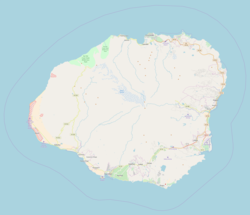Wikiversity
Contents
Wailua Complex of Heiaus | |
 Pōhaku Hoʻohānau (birthing stone) and Pōhaku Piko (umbilical stone), Holoholokū Heiau | |
| Nearest city | Wailua, Hawaii |
|---|---|
| Coordinates | 22°2′41″N 159°20′14″W / 22.04472°N 159.33722°W |
| NRHP reference No. | 66000297 |
| Significant dates | |
| Added to NRHP | October 15, 1966[1] |
| Designated NHLD | December 29, 1962[2] |
Wailua River State Park and the Wailua Complex of Heiaus, which it includes, are located on the eastern side of the Hawaiian island of Kauai. The park consists primarily of the Wailua River valley, which is the only navigable river in Hawaii. Visitors to this park can kayak, take riverboat cruises and explore the rainforest. Even motorboats and water skiing are permissible on the river.
Wailua Complex of Heiaus
The Wailua Complex of Heiau, a National Historic Landmark,[2] was once the center of chiefly power on the island. It contains the remains of several important structures: places of worship (heiau), places of refuge (puʻuhonua), and sites related to royal births.[3] The historical value of these sites are irreplaceable to the Hawaiian culture. They work with other heiau on other islands as well, such as Puʻu O Mahuka on the island of Oʻahu [4]. The most important sites are:[5]
- Hikinaakalā (Rising of the Sun) Heiau, which includes the Hauola place of refuge (puʻuhonua) and the Ka Pae Kiʻi Mahu O Wailua[6] ancient petroglyphs, at the mouth of the river adjacent to Lydgate State Park[7]
- Malae, also known as Malaea or Makaukiu or Mana Heiau, was a walled and paved luakini (sacrificial) heiau totalling a little over two acres. It is currently the largest heiau on Kauaʻi, after the destruction of Kuhiau Heiau at Kalapaki. Kuhiau Heiau had a companion heiau that was used in tandem by Kahuna (native doctors/scientists) in it’s heyday, and so did Malae Heiau. The companion of Malae Heiau was Poliahu Heiau, that sits on a northern bluff across Wailua River[8].
- Holoholokū Heiau, also known as Kalaeokamanu, adjacent to the pōhaku hoʻohānau (birthing stone) and pōhaku piko (navel/umbilical stone), where women of high rank would give birth and bury their afterbirth and umbilical cords[7]. This heiau is the oldest heiau on Kauaʻi, and was the site of the first sacrifice. Originally included an ancient cemetery and coconut grove for an area totalling over thirteen acres, today it is classified as less than an acre [4].
- Poliʻahu (also spelled Poliahu) Heiau, a walled and paved large luakini heiau, over one acre, high on the narrow ridge between ʻŌpaekaʻa Stream and Wailua River[7]. It had a view of other heiau in the complex, and it’s companion Malae heiau especially, was in plain view.
- Bellstone (on the same ridge), used to announce important events, such as royal births[7], or war canoes approaching Wailua Bay.
Of these, only Holoholokū has been largely restored.[5]
Heiau images
-
Hikinaakalā Heiau
-
Kiʻi Pōhaku image
-
Hauola Heiau altar
-
Ka Lae O Ka Manu Heiau (from near birthing stones)
-
Poliʻahu Heiau (looking inland)
-
Poliʻahu Heiau (looking seaward)
-
Poliʻahu Heiau view of Wailua River mouth and Malae Heiau hillside
-
Poliʻahu Heiau view of Wailua River, Kamokila Hawaiian Village (at right), and Fern Grotto tour boat
-
Kamokila Hawaiian Village
-
Sketch by Hiram Bingham I
History
Wailua was the land of the ali'i (kings) and was one of the largest ahupuaʻa (subdivisions) on Kauai. It is said that King Kaumuali'i's favorite place to live was in Wailua. The huaka'i po (Ghost Warriors) are said to walk ancient trails along the river at night up to Mount Waiʻaleʻale. Wailua has many moʻo ʻōlelo (ancient stories) of the area that begins at Hikinaʻakalā heiau to Kaʻawakoʻo atop Mount Waiʻaleʻale, the area long known as the King’s highway, and it is still very sacred to many Hawaiians.
See also
References
- ^ "National Register Information System". National Register of Historic Places. National Park Service. January 23, 2007.
- ^ a b "Wailua Complex of Heiaus". National Historic Landmark summary listing. National Park Service. Retrieved July 3, 2008.
- ^ "Hawaii State Parks: Wailua River State Park". Retrieved December 5, 2009.
- ^ a b "National Register of Historic Places Inventory - Nomination Form" (PDF). Retrieved October 3, 2024.
- ^ a b "NRHP Inventory—Nomination Form". Retrieved May 23, 2012.
- ^ "Ka Pae Kiʻi Mahu O Wailua: The Petroglyphs of Wailua, District of Lihuʻe, Island of Kauaʻi. Site 50-30-08-105A". Retrieved October 3, 2024.
- ^ a b c d Kirch, Patrick Vinton (1996). "Heiau Complex at Wailua". Legacy of the Landscape: An Illustrated Guide to Hawaiian Archaeological Sites. Honolulu: University of Hawaii Press. pp. 16–19. ISBN 0-8248-1739-7.
- ^ "Archaeological Condition Report for Ahukini-Lydgate Segment of the Kauaʻi Pathways Project" (PDF). Retrieved October 3, 2024.


























